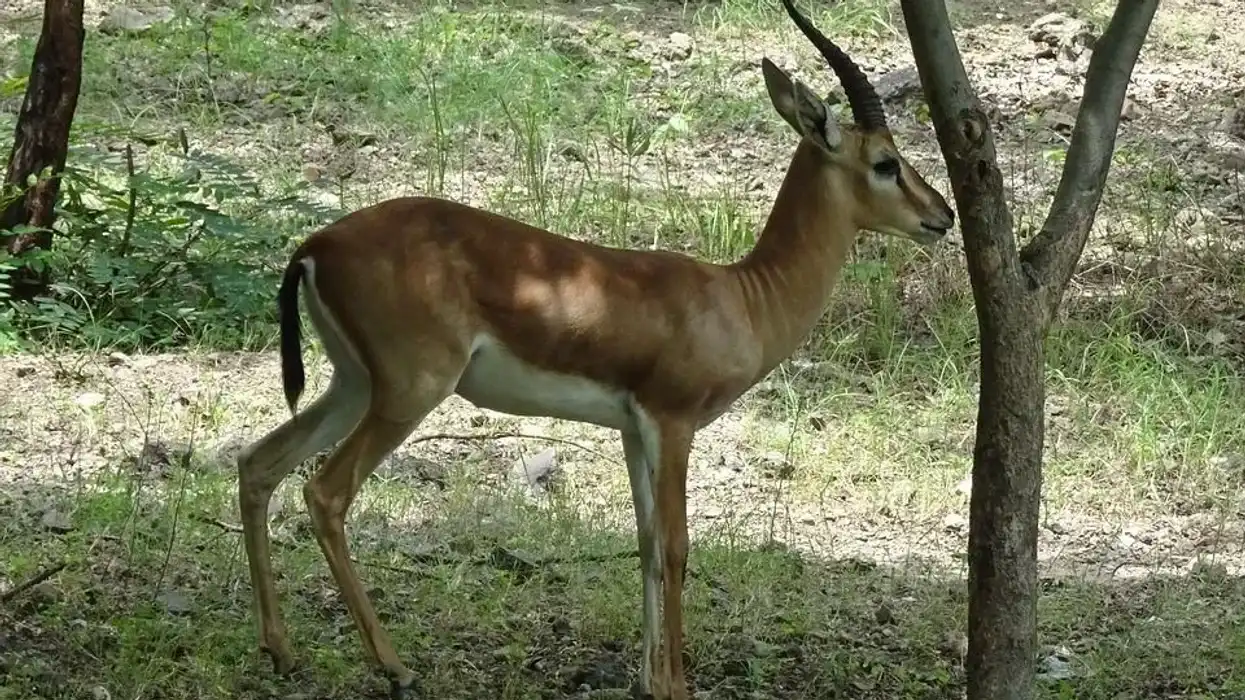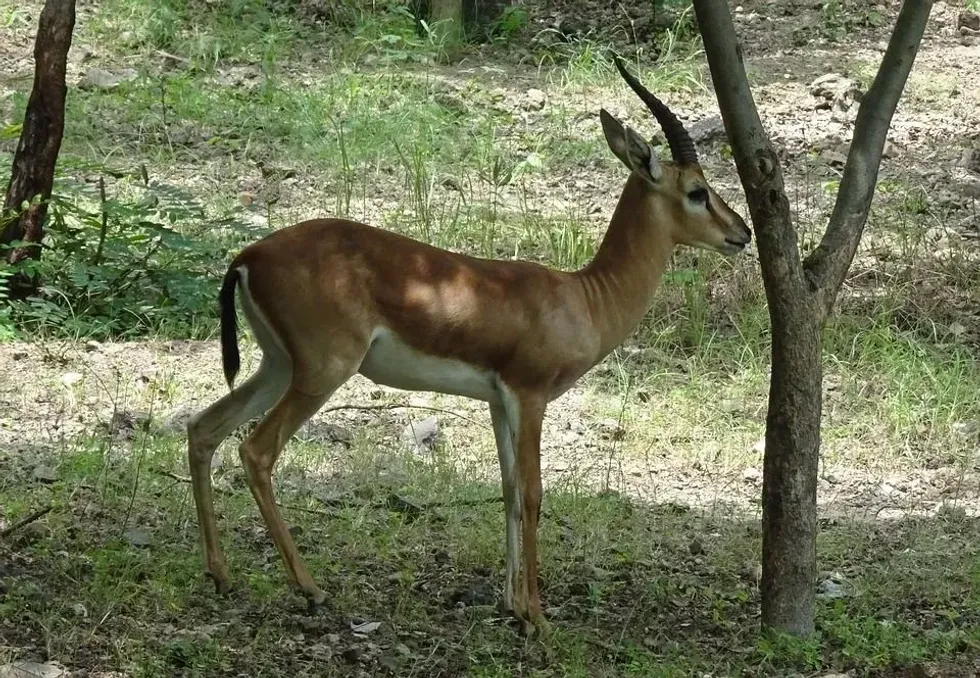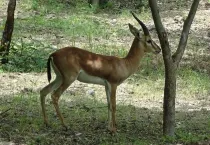Chinkara (Gazella bennettii) is a gazelle species which is fairly common in some parts of the world. The species is characterized by its striking features, such as the chestnut colored stripes and black, twisted horns.
Even though the horns might let us to believe otherwise, chinkaras are shy animals. However, at the same time, they can also be very protective and territorial.
These animals are found in a range of habitats, which ensures that they are hardy and adaptive. In some parts of India, they are also held as sacred, while in most other parts of their habitat range, it is illegal to hunt them.
Chinkaras have a fairly large population count as of yet, but the numbers have been decreasing for a few reasons. One of the most potent reasons behind such decline in numbers is habitat loss.
Another reason why the population may have been decreasing is illegal hunting. This is why protected areas have been created throughout their range of habitat so that the animals can thrive and multiply in great numbers.
They are viviparous animals, which means that they give birth to young ones instead of laying eggs. Baby chinkara is born after five months of gestation and is weaned for a period of two months. Whether or not both the male and female parents take up equal responsibilities is unknown. Keep reading to know more facts!
Chinkara Interesting Facts
What type of animal is chinkara?
The chinkara is a type of Gazella species that is also known as the Indian gazelle. This name is given in accordance with the many chinkaras that can be found in parts of India.
What class of animal does chinkara belong to?
Chinkara (Gazella bennettii) is a mammal, and hence, it belongs to a class named Mammalia.
How many chinkaras are there in the world?
According to records, there are around 50,000-70,000 different types of chinkaras in the world.
Where does chinkara live?
The Indian gazelle or chinkara can be found in several different ranges of habitats. The chinkara range extends from arid plains and hills to open woodlands and forests. They can also be found in dry, deciduous forests. This means that this gazelle species is very hardy and adaptive when it comes to climatic conditions.
What is a chinkara's habitat?
The Indian gazelle (Gazella bennettii), as the name suggests, can be found in many places across India. It is not uncommon to find this animal in places such as the Thar desert, Pakistan, Afghanistan, and Iran.
The Indian chinkara population has seen somewhat of a fall in recent years, however, it is still considered to be stable. The animal can be seen in many protected areas in India such as a national park.
Who do chinkaras live with?
Chinkaras usually live in small groups of around four individuals. In some protected areas in India, they walk around lazily, whilst feeding on bits and scraps here and there.
How long does chinkara live?
The maximum life expectancy of an Indian gazelle (Gazella bennettii), when in captivity, is of over 12 years. The chinkara life expectancy is reduced in its natural habitat due to predators and habitat loss.
How do they reproduce?
Chinkaras are mammals, which means that they give birth to young ones just like humans do. Across the chinkara habitat, there are two main breeding seasons. One of them goes on from March to April, while the other runs from August to October.
A female Indian gazelle can give birth every year after it reaches sexual maturity. They do so at the age of one year and can give birth to as many as three young ones each year.
The gestation period is of a little over five months, after which the young ones are weaned for two months. Males of the species acquire sexual maturity later as compared to females.
What is their conservation status?
According to the IUCN Red List, the conservation status of the Indian gazelle is of the Least Concern. This means that these beautiful animals are likely to be around for many more years.
However, it is also important to understand that when not within the confines of a national park or any such protected areas, these animals are threatened by many factors such as habitat loss and predatory animals. Hunting is another problem that threatens a decrease in the chinkara population around the world.
Chinkara Fun Facts
What do chinkaras look like?
Chinkaras are beautiful animals of the gazelle family. They have long horns and chestnut or brown-colored bodies. They also have chestnut-colored stripes that run from the corner of the eye, which have white-colored borders. The dark chestnut stripes characterize the species and make them look absolutely stunning.
How cute are they?
With the dark chestnut stripes running from the corner of the eye, and white stripes that border them, chinkaras or Indian gazelles are beautiful creatures. They are not only adorable but have an almost regal appearance, which is why the chinkara population is important to people throughout the world.
How do they communicate?
The Indian gazelle (Gazella bennettii) species communicates through a sound which almost sounds like a sneeze. Such sounds are mostly created by these animals when they sense any threat. This is one of the reasons why they are often referred to as the sneezers!
How big is a chinkara?
The chinkara size is pretty average. The range of their length remains within 3-4 ft (0.9-1.2 m). They also around 1.9-2.6 ft (0.6-0.8 m) tall and have long horns as well.
How fast can a chinkara run?
Chinkaras can be considered to be fast animals. They can run with an average speed of 37.2 mph (60 kph).
How much does chinkara weigh?
The average weight of chinkara has a range of around 44-55 lb (20-25 kg).
What are the male and female names of the species?
Unfortunately, there are no special names for the male and female chinkaras. Hence, we will simply have to refer to them as the male chinkara and female chinkara.
What would you call a baby chinkara?
There are no special names for the baby Indian gazelle either!
What do they eat?
The chinkara diet is strictly herbivorous. These animals sustain themselves on a diet that consists of grass, leaves, small plants, fruits, and vegetables. They also help in the dispersal of seeds since they are so fond of eating fruits.
Are they dangerous?
There is no evidence that would lead us into believing that the chinkara population of the world is dangerous for humans. They are meek animals that hide in the desert or grassland at the slightest threat. However, it is best to not threaten the Indian chinkara population in any way.
Would they make a good pet?
Chinkaras are wild animals that can be found in a desert or grassland. This species can be visited at a national park but it is illegal to have a chinkara as a pet.
Did you know...
The chinkara distribution is widespread throughout India, Pakistan, Iran and Afghanistan.
The population of this species is threatened due to habitat loss.
Grassland and woodland depletion is one of the many reasons why the chinkara population has been dropping.
It is illegal to hunt chinkaras in most parts of the world.
Attempts are being made to stabilize the population by creating protected areas.
The temperament of the chinkara
Chinkaras tend to be territorial animals. They can be very defensive about their area and can attack each other. However, they are not as brave around any predators and tend to become very scared.
What is the importance of chinkara?
The chinkara population of the world is a very potent tool for the dispersal of seeds. This is because these animals eat a lot of fruits and vegetables, whose seeds naturally pass through their digestive system. Hence, they form an important part of the forest ecosystem.









